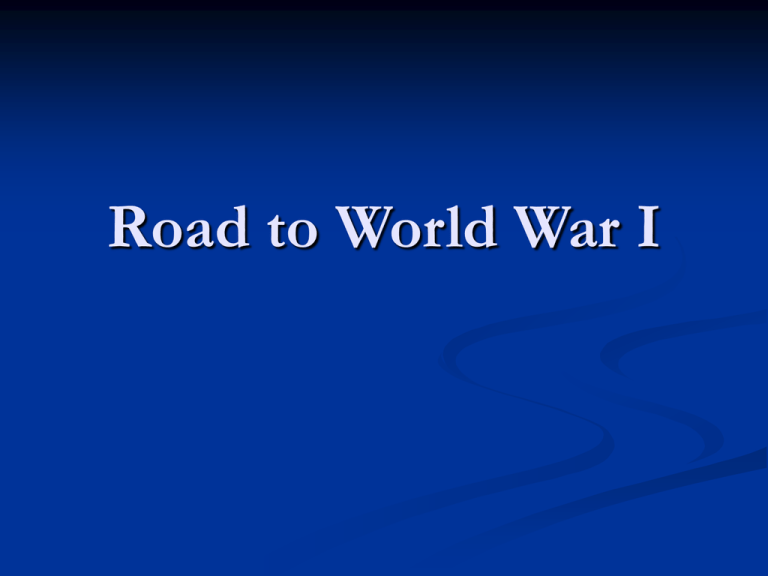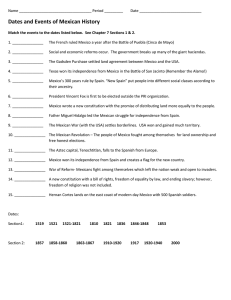Road to World War I
advertisement

Road to World War I America in the Caribbean No major powers directly challenged American objectives in the Caribbean. American leaders viewed Caribbean stability as critical to American security American business was heavily invested in the region— needed stable government to do business In the two decades following the Spanish-American War, U.S. intervened no fewer than 20 times Combination of strategic and commercial interests Pressures on the military In the post-Spanish-American War army, generally 1/3 served at overseas postings. Large numbers of forces in Philippines, Cuba, Hawaii, Alaska and China. Marines step forward to assume much of the duty as “quick-response force” Logical choice—close ties to Navy Looking for a mission Cuba Despite the Teller Amendment, Cuba did not emerge from the war a truly independent nation. American military remained to maintain stability Controlled a provisional government Forced Cuba to lease bases-Guantanamo Bay U.S. intervened again in 1906, 1912 and 1917 to protect interests U.S. Occupation 1908 Development of Panama Canal U.S. had long desired a canal through Central America 66 day voyage of USS Oregon demonstrated need during SpAm War 1903—Intervenes in Civil War in Columbia Permits emergence of independent Panama Signs canal treaty with new Panamanian gov. U.S. granted a lease for a 10 mile strip of land Army given the task of constructing the canal General George Goethals Colonel William Gorgas—sanitation and tropical diseases Nicaragua U.S. send forces into the region several times Troops in the region in 1909, 1912. Marines remained in the region for over two decades. Marines in Nicaragua Mexican Campaign Wilson allows U.S. to be repeatedly dragged into Mexican affairs. Unstable political situation—resentment toward U.S. Tampico Incident—U.S. sailors arrested US demands apology and salute of flag Mexico refuses—US bombards and occupies port of Vera Cruz. War seems likely-avoided by resignation of Mexico’s leader Punitive Campaign Pancho Villa, resents American support for new Mexican government government Attacks Columbus, NM John Pershing sent to deal with Villa Creates tension with Mexican government No clear mission Clashes with Mexican government troops. U.S. Army looks inept. War with Mexico looks likely Events in Europe shift American focus Benefits of Punitive Campaign Puts end to serious border problems with Mexico Provides intensive field training for Regulars and National Guard Reveals weaknesses—time to correct 1st use of aircraft in combat--ineffective Provides John Pershing with a command opportunity National Defense Act of 1916 Nation senses threat of war in Europe Extended the time National Guard Units could serve Asserts that all men 18 to 45 are subject to military service Prepares way for Selective Service Act (1917) Increases size of Regular army and National Guard Problem—Spread over 5 years When war starts—Army not ready Preparedness Campaign Many American urged immediate steps to prepare the nation for war Summer Camps—General Leonard Wood 1st camp—Plattsburgh, NY Young men learned drill and discipline Hoped to be in line for officer positions in expanded wartime army War in Europe Decent to war begins in June 1914 with assassination of heir to Austria-Hungarian Throne. Product of long brewing tensions in the Balkans region over political freedom Austria-Hungarian Empire was a weak Conflict should have remained a local dispute, except to complicated set of treaties and alliances dividing Europe into two armed camps. Complex set of alliances had kept Europe at peace since 1871. Fairly effective in maintaining peace— Danger--Risk of a small conflict exploding Two great camps: Triple Alliance—Germany, Austria-Hungary, Italy Triple Entente—Great Britain, France and Russia Struggles over control of Eastern and Western Europe. Eastern-Russia vs. Austria-Hungary Western-Germany vs. France Pressure over control of the seas Great Britain vs. Germany Schleiffen Plan Germany understood the risks presented by a two-front war against France and Russia. Developed war plan to deal with prospects. General Alfred von Schlieffen(1905) Attack France immediately—invading through Belgium and swinging into France. Strong right wing sweeps into France. Expected to defeat France within 6 weeks. Move troops to Russian front. Assume Russia will be very slow to mobilize its forces. Schlieffen Plan Problem with Germany Strategy German plan depended on perfect timing. Needed to defeat France in a very short period of time Needed Russia to be slow in mobilizing its forces. Germany’s only war plan Required to make it fit any situation. Ultimately will push the crisis further. Consequences of Assassination A-H deliver ultimatum to Serbia. Serbia gives into all A-H demands. A-H still declares war. Russia turns to support Serbia, it’s ally. Germany panics over Russian mobilization Orders mobilization of army. Danger to Schleiffen Plan Attacks Belgium to keep plan on track. Draws Britain into war Reaction to outbreak of war Celebrations throughout Europe Few understood horror of modern warfare Most thought the conflict would be quick and decisive Home for Christmas Advantages Triple Entente Held advantage in numbers and financial resources Command of the Sea Triple Alliance Interior lines of communication Initiating the attack German Attack Schleiffen Plan almost succeeds Modified the Schlieffen Plan weakening the right wing Underestimated the time needed for the Russians to mobilize British and French forces able to stop the Germans on the outskirts of Paris. No Quick Victory The two camps were evenly matched 1st major wartime use of machine guns and barbed war made it easier to defend than to attack. Troops began to dig into trenches to protect themselves from artillery attacks. Line quickly stretches from Belgium to the Swiss Border. French Trench (1916) Submarine Warfare Germany since it was weaker than Britain on the seas need to deploy alternate weapons Submarine becomes weapon of choice. French and especially the British were vulnerable to the form of attack Imported much of their food Use of Submarine Could not operate under ordinary rules of war Too vulnerable on the surface Realized the British were highly vulnerable Declare a war zone around British Isles Will sink all enemy merchant ships without warning American attitude Seemed barbaric that defenseless civilians should be killed without warning Refused to surrender their rights as neutrals. Should be able to sail on any ship, at any time. Lusitania Submarine U-20 sinks the British Liner Lusitania off the Irish coast. Killed 1,200 persons, including 128 Americans. Strong reaction in America Wilson demands that Germany promise to stop attacking Attack on French steamer Sussex Germany finally pledges to stop attacking merchant ships without warning Calculated Risk Germany knew it would need to renounce the Sussex pledge. Armed with over 100 U-Boats, German leader believed they could starve Allies by cutting off American supplies Understood America would enter war, believed would defeat Allies before American could make impact Feb 1, 1917—Unrestricted Submarine Warfare. Zimmermann Telegram Germans have a secret plan to form an alliance with Mexico Mexico would receive Texas, New Mexico and Arizona. Reveals to American public the intentions of the German government.





